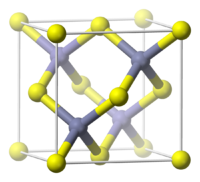Aluminium phosphide

| |
| Names | |
|---|---|
| Other names
Aluminium(III) phosphide
Aluminium monophosphide Phostoxin Fumitoxin | |
| Identifiers | |
3D model (JSmol)
|
|
| ChemSpider | |
| ECHA InfoCard | 100.040.065 |
PubChem CID
|
|
| RTECS number |
|
| UNII | |
CompTox Dashboard (EPA)
|
|
| |
| |
| Properties | |
| AlP | |
| Molar mass | 57.9552 g/mol |
| Appearance | yellow or gray crystals |
| Density | 2.85 g/cm3, solid |
| Melting point | 2530 °C |
| reacts | |
| Band gap | 2.5 eV (indirect)[1] |
Refractive index (nD)
|
2.75 (IR), ~3 (Vis) [1] |
| Structure | |
| Zincblende | |
| T2d-F43m | |
a = 546.35 pm
| |
| Tetrahedral | |
| Hazards | |
| NFPA 704 (fire diamond) | |
| Flash point | >800 °C |
| Lethal dose or concentration (LD, LC): | |
LD50 (median dose)
|
11.5 mg/kg |
Except where otherwise noted, data are given for materials in their standard state (at 25 °C [77 °F], 100 kPa).
| |
Aluminium phosphide (Template:AluminiumTemplate:Phosphorus) is an inorganic compound used as a wide band gap semiconductor and a fumigant. This colourless solid is generally sold as a grey-green-yellow powder due to the presence of impurities arising from hydrolysis and oxidation.
Properties
AlP crystals are dark grey to dark yellow in color and have a zincblende crystal structure[2] with a lattice constant of 5.4510 Å at 300 K.[3] They are thermodynamically stable up to 1,000 °C (1,830 °F).[4]
Aluminium phosphide reacts with water or acids to release phosphine:[5]
- AlP + 3 H2O → Al(OH)3 + PH3
- AlP + 3 H+ → Al3+ + PH3
Preparation
AlP is synthesized by combination of the elements:[4][6]
- 4Al + P4 → 4AlP
Caution must be taken to avoid exposing the AlP to any sources of moisture, as this generates toxic phosphine gas.
Uses
Pesticide
AlP is used as a rodenticide, insecticide, and fumigant for stored cereal grains. It is used to kill small verminous mammals such as moles and rodents. The tablets or pellets typically also contain other chemicals that evolve ammonia which helps to reduce the potential for spontaneous ignition or explosion of the phosphine gas.
AlP is used as both a fumigant and an oral pesticide. As a rodenticide, aluminium phosphide pellets are provided as a mixture with food for consumption by the rodents. The acid in the digestive system of the rodent reacts with the phosphide to generate the toxic phosphine gas. Other pesticides similar to aluminium phosphide are zinc phosphide and calcium phosphide. In this application, aluminium phosphide can be encountered under various brand names, e.g. Celphos, Fumitoxin, Phostoxin, and Quick Phos. It generates phosphine gas according to the following hydrolysis equation.[6]
- 2 AlP + 6 H2O → Al2O3∙3 H2O + 2 PH3
It is used as a fumigant when other pesticide applications are impractical and when structures and installations are being treated, such as in ships, aircraft, and grain silos. All of these structures can be effectively sealed or enclosed in a gastight membrane, thereby containing and concentrating the phosphine fumes. Fumigants are also applied directly to rodent burrows.[7]
Evidently poisonous, aluminium phosphide has been used for suicide.[8] Fumigation has also caused unintentional deaths, such as examples in Saudi Arabia[9] and the United States.[10] Known as "rice tablet" in Iran, for its use to preserve rice, there have been frequent incidents of accidental or intentional death. There is a campaign by Iranian Forensic Medicine Organization to stop its use as a pesticide.[11]
Aluminium phosphide poisoning is considered a wide-scale problem in the Indian subcontinent.
Semiconductor applications
Industrially, AlP is a semiconductor material that is usually alloyed with other binary materials for applications in devices such as light-emitting diodes (e.g. aluminium gallium indium phosphide).[12]
References
- ^ a b L. I. Berger "Semiconductor materials" CRC Press, 1996 ISBN 0-8493-8912-7, p. 125
- ^ Van Zeghbroeck, Bart J. (1997). "Bravais Lattices; Zincblende Lattice". University of Colorado. Retrieved 10/02/2011.
{{cite web}}: Check date values in:|accessdate=(help) - ^ "Lattice Constants". SiliconFarEast.com. 2004. Retrieved 10/02/2011.
{{cite web}}: Check date values in:|accessdate=(help) - ^ a b Wayne E. White and A. H. Bushey (1953). "Aluminum Phosphide". Inorg. Synth. 4: 23–25. doi:10.1002/9780470132357.ch7.
- ^ Holleman, Arnold Frederik; Wiberg, Egon (2001), Wiberg, Nils (ed.), Inorganic Chemistry, translated by Eagleson, Mary; Brewer, William, San Diego/Berlin: Academic Press/De Gruyter, ISBN 0-12-352651-5
- ^ a b White, Wayne E.; Bushey, A.H. (1944). "Aluminum Phosphide – Preparation and Composition". J. Am. Chem. Soc. 66 (10): 1666. doi:10.1021/ja01238a018.
{{cite journal}}: CS1 maint: multiple names: authors list (link) - ^ Buckle, Alan. "Rodenticides". Ullmann's Encyclopedia of Industrial Chemistry. Weinheim: Wiley-VCH. doi:10.1002/14356007.a23_211. ISBN 978-3527306732.
- ^ "Millionaire's death sparks poison scare". BBC News. 2002-10-10. Retrieved 2009-04-05.
- ^ "Fumes kill two Danes in Jeddah". BBC News. 2009-02-24. Retrieved 2009-02-25.
- ^ "Family loses 2nd child in suspected pesticide poisoning". KSL-TV. 2010-02-09. Retrieved 2010-02-09.
- ^ Mehrpour, O; Singh, S (2010). "Rice tablet poisoning: A major concern in Iranian population". Human & Experimental Toxicology. 29 (8): 701–2. doi:10.1177/0960327109359643. PMID 20097728.
- ^ D. E. C. Corbridge "Phosphorus: An Outline of its Chemistry, Biochemistry, and Technology" 5th Edition Elsevier: Amsterdam 1995. ISBN 0-444-89307-5.

